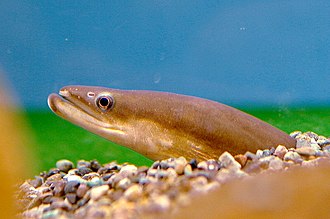ICHTHYOLOGY: ASIA – Endangered: The Japanese Eel
Adored and endangered: the complex world of the Japanese eel
Consumed worldwide, eel is particularly popular in Asia, and perhaps nowhere more so than Japan, where remains found in tombs show it has been eaten on the archipelago for thousands of years]
.
.
TRIVIA:
Definition. Ichthyology is the branch of zoology devoted to the study of fish, including: bony fish, Osteichthyes; cartilaginous fish, Chondrichthyes; and jawless fish, Agnatha. The discipline can include the biology, taxonomy and conservation of fish, as well as husbandry and commercial fisheries.
.
From Wikipedia, the free encyclopedia
.
Japanese eel
| Japanese eel | |
|---|---|
 |
|
| Scientific classification |
|
| Kingdom: | Animalia |
| Phylum: | Chordata |
| Class: | Actinopterygii |
| Order: | Anguilliformes |
| Family: | Anguillidae |
| Genus: | Anguilla |
| Species: |
A. japonica
|
| Binomial name | |
| Anguilla japonica | |
| Synonyms | |
|
|
The Japanese eel (Anguilla japonica; Japanese: 日本鰻 nihon’unagi[2]) is a species of anguillid eel found in Japan, Korea, China, and Vietnam,[3] as well as the northern Philippines. Like all the eels of the genus Anguilla and the family Anguillidae, it is catadromous, meaning it spawns in the sea, but lives parts of its life in fresh water. The spawning area of this species is in the North Equatorial Current in the western North Pacific to the west of the Mariana Islands. The larvae are called leptocephali and are carried westward by the North Equatorial Current and then northward by the Kuroshio Current to East Asia, where they live in rivers, lakes, and estuaries. The Japanese eel is an important food fish in East Asia, where it is raised in aquaculture ponds in most countries in the region. In Japan, where they are called unagi, they are an important part of the food culture, with many restaurants serving grilled eel, which is called kabayaki.
Life history and habitat
The Japanese eel and other anguillid eels live in fresh water and estuaries where they feed and grow as yellow eels for a number of years before they begin to mature and become silver eels. The silver eels then migrate out of fresh water into the ocean and start their long journey to their spawning area. Adult Japanese eels migrate thousands of kilometers from freshwater rivers in East Asia to their spawning area without feeding.[4] The spawning area of this species was discovered in 1991 by collecting small leptocephali about 10 mm in size, and then in 2005 the same team of Japanese scientists at the University of Tokyo found a more precise location of spawning based on genetically identified specimens of newly hatched preleptocephali only 2 to 5 days old in a small area near the Suruga Seamount to the west of the Mariana Islands (14–17° N, 142–143° E).[5]
Since then, more pre-leptocephali have been collected at sea, and even Japanese eel eggs have been collected and genetically identified on the research vessel. The collections of eggs and recently hatched larvae have been made along the western side of the seamount chain of the West Mariana Ridge. Mature adults of the Japanese eel and giant mottled eel were captured using large midwater trawls in 2008 by Japanese scientists at the Fisheries Research Agency.[6] The adults of the Japanese eel appear to spawn in the upper few hundred meters of the ocean, based on the recent catches of their spawning adults, eggs, and newly hatched larvae. The timing of catches of eggs and larvae and the ages of larger larvae have shown that Japanese eels only spawn during the few days just before the new moon period of each month during their spawning season.
After hatching in the ocean, the leptocephali are carried westward by the North Equatorial Current and then northward by the Kuroshio Current to East Asia. In the open ocean, the larvae feed on marine snow, before they metamorphose into the glass eel stage. The glass eels then enter the estuaries and headwaters of rivers and many travel upstream. In fresh water and estuaries, the diet of yellow eels consists mainly of shrimp, other crustaceans, aquatic insects, and small fishes.[7]
The Japanese eel population, along with anguillid eel populations worldwide, have declined drastically in recent years, presumably due to a combination of overfishing and habitat loss or changing water conditions in the ocean interfering with spawning and the transport of their leptocephali. In the case of the Japanese eel, spawning is likely affected by the north-south shifts of a salinity front created by an area of low-salinity waters resulting from tropical rainfall. The front is thought to be detected by the adult spawning eels and to affect the latitudes at which they spawn. A northward shift in the front that occurred over the past 30 years appears to have occurred, which could cause more larvae to be retained in eddies offshore in the region east of Taiwan, and southward shifts in the salinity front have been observed in recent years that could increase southward transport into the Mindanao Current that flows into the Celebes Sea. These types of unfavorable larval transport are thought to reduce the recruitment success of the Japanese eels that reach river mouths as glass eels.[8]
Commercial fisheries
| show Detailed time series |
|---|
Medical use
The Japanese freshwater eel produces a fluorescent protein, which makes it unique among vertebrates. This protein has been used in an experimental diagnostic test to assess liver function.
.

















